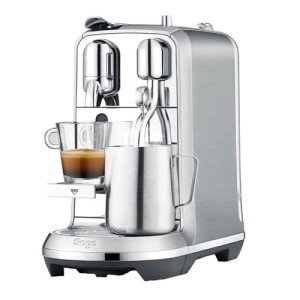The World of High-Quality Espresso Machines: A Comprehensive Guide
Espresso has actually become a precious drink amongst coffee lovers worldwide, understood for its abundant taste, intense scent, and adaptability. The heart of a great espresso depends on the machine utilized to brew it. High-quality espresso machines are developed to deliver the best shot, making them an essential financial investment for coffee enthusiasts. This post explores various types of high-quality espresso machines, their functions, upkeep pointers, and answers to regularly asked concerns.
Types of High-Quality Espresso Machines
High-quality espresso machines fall into numerous categories, dealing with various choices, skill levels, and spending plans. The main types consist of:
| Type of Machine | Description | Suitable User |
|---|---|---|
| Manual Espresso Machines | Needs user skill to control extraction and pressure. Offers the most control over the developing process. | Experienced baristas and enthusiasts |
| Semi-Automatic Machines | Combines manual operation with automation. Users manage the grind and tamping, while the machine deals with water dispersion. | Intermediate users |
| Automatic Espresso Machines | Automate the developing process, enabling programmable developing times and temperatures. | Casual coffee drinkers |
| Super-Automatic Machines | Have integrated grinders and are totally automated, dealing with everything from grinding to developing and steaming. | Users looking for convenience |
| Commercial Espresso Machines | Designed for high volume use in cafes and dining establishments, using durability and speed. | Company owner |
In-depth Overview of Each Type
Manual Espresso Machines
- Pros: Complete control over the brewing procedure; can produce extraordinary quality espresso.
- Cons: Requires considerable ability; lengthy.
Semi-Automatic Machines
- Pros: Balanced control, blending manual and automatic processes; exceptional quality espresso is still possible.
- Cons: Requires some knowledge and experience to master.
Automatic Espresso Machines
- Pros: User-friendly; decreases the discovering curve while still producing high-quality espresso.
- Cons: Still requires some understanding of coffee-making basics.
Super-Automatic Machines
- Pros: Maximal benefit; little skill needed; perfect for individuals or families who desire coffee without difficulty.
- Cons: Higher rate point; may lack the fine-tuning abilities of manual machines.
Commercial Espresso Machines
- Pros: Built for durability and efficiency; frequently consists of functions for high-volume turns.
- Cons: Expensive; might be overkill for home use.
Secret Features to Consider
When trying to find a high-quality espresso machine, a number of crucial features should be considered:
- Pressure and Pump Type: Look for machines with a minimum of 9 bars of pressure, which is necessary for extracting the very best taste from coffee beans.
- Boiler Type: Single, double, and heat exchanger boilers each affect how the machine carries out and the speed of developing.
- Build Quality: High-quality products such as stainless-steel are more suitable for sturdiness and aesthetics.
- Ease of Use and Cleaning: Some machines need substantial cleansing, while others are developed for simple upkeep.
- Temperature Control: Consistent temperature is vital; think about machines with PID controllers for exact control.
Advantages of High-Quality Espresso Machines
Investing in a high-quality espresso machine uses a plethora of benefits:
- Superior Quality: High-end machines permit greater control, causing tastier espresso.
- Sturdiness: Built to last, quality machines need less repairs and replacements.
- Customization: Users can enjoy a tailored experience by adjusting grind size, shot timing, and other settings.
- Increased Convenience: Automatic and super-automatic choices enable connoisseurs to delight in espresso with very little effort.
Upkeep and Care for High-Quality Espresso Machines
To keep an espresso machine working efficiently, regular maintenance is essential. Here are pointers for keeping a high-quality espresso machine:
Descale Regularly:
- Use a descaling service every few months to avoid buildup of minerals from water, which can affect flavor and efficiency.
Clean the Brew Group:
- For machines with a removable brew group, tidy it frequently to ensure a tidy extraction.
Change Water Filters:
- Use a water filter and change it as required to reduce impurities in your brewing water.
Daily Cleanings:
- Rinse the portafilter and group head after each use to avoid oil accumulation.
Watch on the Parts:
- Monitor seals, gaskets, and other parts for wear and tear and change them as necessary.
Regularly Asked Questions (FAQs)
1. What is the best espresso machine for beginners?
For newbies, a semi-automatic machine typically provides a good balance of usability and control, enabling users to find out the skills essential for making terrific espresso.
2. Are super-automatic machines worth the financial investment?
Yes, for those who focus on benefit and ease over control, super-automatic machines can be a worthwhile financial investment, specifically for households or hectic professionals.
3. Just how much should I expect to spend on a high-quality espresso machine?
High-quality espresso machines vary substantially in price, with manual machines starting at a couple of hundred dollars, while super-automatic or commercial machines can go beyond several thousand.
4. Can I make other coffee beverages with an espresso machine?
Yes, lots of espresso machines have steam wands or accessories that permit users to develop lattes, coffees, and more.
5. The length of time do espresso machines generally last?
With proper maintenance, high-quality espresso machines can last over a decade, making them a long-term financial investment in your coffee enjoyment.
High-quality espresso machines yield a transformative coffee experience, whether taken pleasure in at home or in a commercial setting. By understanding simply click the up coming web site , their functions, and the maintenance needed to keep them running effectively, consumers can make informed choices that elevate their coffee-drinking experience.

